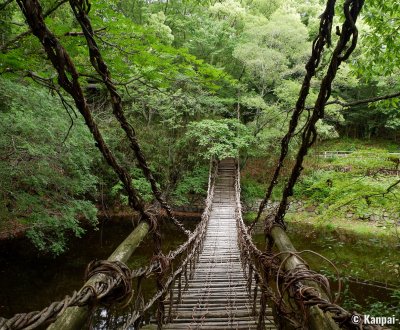Shikoku Mura
The Essential of Shikoku in Takamatsu
Shikoku Mura is an architectural village located at the foot of Mount Yashima in the east of Takamatsu City, Kagawa Prefecture. About 30 traditional rural homes, old farm houses and workshops have been relocated and restored in an open-air museum in the heart of the forest. An art gallery designed by Tadao Ando was added in 2002.
Shikoku Mura is a park harboring the essentials of Shikoku Island and Hyogo prefecture’s architecture, on a roughly 50,000m² superficies in a steep woody landscape on the side of the mountain. The traditional Japanese architecture of wood and stone is elaborately associated to Brutalist contemporary architecture to create a feel of natural sophistication.
The latest construction designed by architect Yoshiyuki Kawazoe was added in 2022 and is called "Oyane san". It is a building made of concrete and wood, covered of a wavy tiled roof that shelters among other things the entrance to the museum and the ticket booth. At its foot, you’ll find Waraya, an old traditional house of the Edo period, with a thatched roof, that was relocated here from the Iya Valley in 1975 as an udon noodles restaurant by the museum’s founder Tatsuo Kato. It was at this occasion that Kato took interest in old houses, with a particular fondness for thatched roofs, and that he endeavored the collection of old houses throughout Shikoku Island and even up to Kobe. The Shikoku Mura Museum was then inaugurated in 1976 with 16 buildings already reconstructed.

Tribute to the regional history and industries
All the buildings on display, houses, mill, brewery or lighthouse, bear the traces of their previous life before being transferred in Shikoku Mura. They were thoughtfully laid out in a forest environment, surrounded by bamboos and leafy trees, along a steep trail of stone, earth or wooden steps that can be slippery.
Different areas are shaped to highlight the industries of the northern part of Shikoku, that were active between the 17th and the early 20th century:
- The extraction of sugar from sugar cane, to make wasanbon sweets;
- The brewing of shoyu soy sauce; and,
- The making of washi Japanese paper.
Visitors can enter in the buildings, look how they were furnished, and discover old tools. Among the structures that were reconstructed one can find:
- A Kazurabashi vine bridge relocated from Iya Valley;
- A kabuki theater stage from Shodoshima;
- Earthen wall houses;
- Storehouses, workshops; and,
- A tea pavilion brought from Ehime.

Artistic spirit and art gallery designed by Tadao Ando
The site welcomed several new buildings over time: the Okunoshima Lighthouses area was added in 1998. Then in 2002, the Shikoku Mura Gallery was built on the heights of the park, with rough concrete walls that are Tadao Ando’s trademark of. The architect also designed the aquatic terraced garden down the gallery, in the same fashion as Awaji Yumebutai. The rose 🌹 garden is particularly interesting in May. The gallery is home to temporary exhibitions of artworks from throughout the world and of various time periods, inspired by Tatsuo Kato’s art collection. The terrace offers a panoramic view on the Sanuki Plain (from the former name of the area).
Shikoku Mura has joined the sites affiliated to the Setouchi Art Triennale in 2019 and various contemporary art installations are dispatched throughout the park. As of today, the site is home to 33 buildings, of which 4 are designated Important Cultural Assets.

A challenging course
The rural village is immersed in a green environment, doted with waterfalls to offer nowadays’ visitors a time for both learning and relaxing. An English-language audio-guide is also available as a free downloadable app. However, be careful where you tread! Despite a perfect maintenance, the path can be hard to walk due to the inclination of the slope, and an often uneven or slippery surface. It is therefore recommended to wear good walking shoes. Moreover, you may encounter wild animals such as boars, snakes and suzumebachi wasps. Regardless, the most annoying ones will probably be mosquitoes in summer.
The visit path comes back to Oyane san building, and the museum’s souvenir shop is used as the exit. Waraya udon noodles restaurant and Wasa House cafe welcome visitors during the museum’s opening hours for the finishing touch of this immersive experience and to gain new strength before carrying on with the exploration of Yashima.

